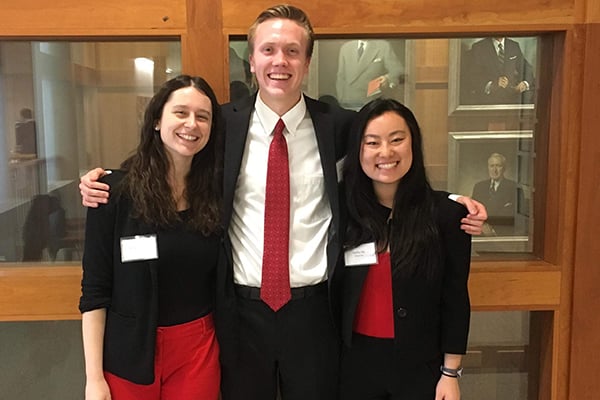Gavin Mischler, Maya Lapinski, and Katherine Hu met through the Department of Biomedical Engineering’s Design Team program during their first year at Johns Hopkins, and spent the next three years developing a reusable device that aims to reduce the rate of childbirth-related deaths for women in low-resource settings. This spring, the team’s dedication resulted in a journal publication and a patent for their device.
The three biomedical engineering undergraduate students joined Maternys, a team of five upperclassmen developing a device designed to treat postpartum hemorrhage, the second-leading cause of maternal mortality in the developing world.
“I was really interested in joining this team because of its focus on maternal health, something that is often overlooked, especially in low-resource settings,” said Hu. “Plus the unique challenge of innovating a low-cost solution and considering all the various barriers to adoption in an international setting was a great learning experience.”
Typical treatment for this dangerous condition involves inserting a balloon-like device into the uterus, where it expands and stops bleeding through the application of pressure. However, this approach comes with challenges when used in low-resource settings, according to Lapinski.
“In the developed world, this is effective since clinicians can use ultrasound and other imaging modalities to keep track of the device’s position. But in the developing world, this isn’t an option,” she explained.
The team’s device does not require the use of ultrasound or other expensive technology. Instead, it incorporates haptic feedback, which allows the user to feel if the device is in place and applying maximum pressure. An adjustable outer sheath allows the device size to be custom fit for a variety of uterine volumes.
As part of the Design Team program, team members benefitted from the input and expertise of engineering faculty mentor Amir Manbachi, assistant professor of neurosurgery, and clinical mentor Rachel Seay, assistant professor of gynecology and obstetrics.
“It was very helpful to have both clinical and faculty mentors because we received different perspectives, which helped us to focus on different areas of design,” said Mischler. “Making a product that would be used by clinicians means it’s critical to have their input.”
The team also interviewed patients and physicians to help them understand the root cause of the problem they were trying to address, and for additional feedback as they refined their prototype over multiple rounds of testing.
Lapinski believes that the transgenerational nature of the team, with upperclassmen providing technical skills and design thinking experience and underclassmen bringing new perspectives, was an asset in more than just the design process. It also meant that Mischler, Lapinski, and Hu began their undergraduate years with guidance and advice from their upperclassmen teammates.
“They gave me advice on Design Team, classes, summer opportunities, social events, and more,” said Hu. “They were largely the reason why I enjoyed my freshman year so much, since I felt like I always had people to talk to.”
Working on the same project for many years allowed the team to experience the whole design process, from discovering the initial need and developing a functional prototype to conducting usability studies and translating their product into the clinic. Team Maternys even traveled to Sierra Leone to immerse themselves in the culture and healthcare ecosystem of the people they were looking to serve.
“None of this would have been possible without long-term dedication to the project,” said Hu. “I would highly recommend that other students consider working on a project for multiple years since you will get exposure to the later stages of the design process, and there is always something more to learn.”
Mischler, Lapinski, and Hu graduated from Hopkins BME this past spring. Mischler will head to Columbia University to begin his PhD in electrical engineering. Lapinski will work for Medtronic before applying to medical school. Hu will be working in healthcare consulting, and also plans to apply to medical school in the future.

